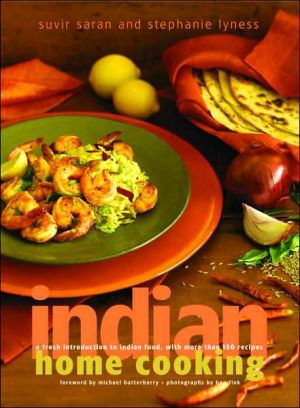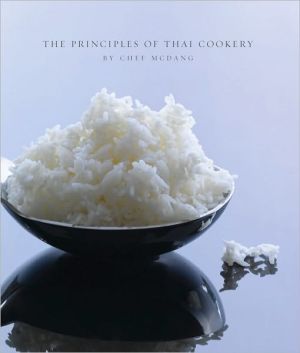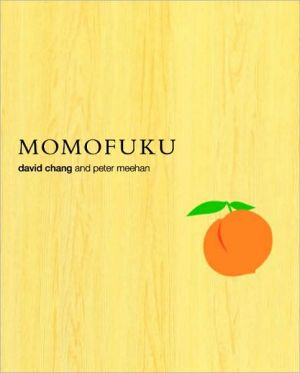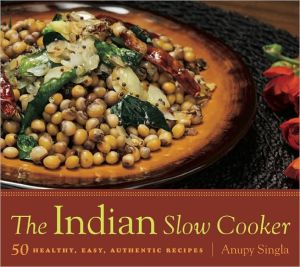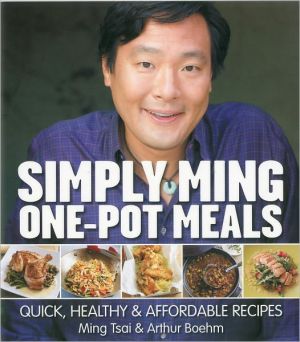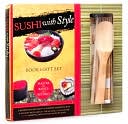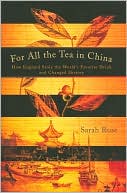Indian Home Cooking: A Fresh Introduction to Indian Food, with More Than 150 Recipes
With its exotic aromas and complex flavors, Indian cuisine is one of the world's best. It's no wonder that so many people adore it—and also no surprise that it could seem daunting to cook Indian food at home. Now, acclaimed chef and cooking teacher Suvir Saran cuts out the fuss, sharing casual, home-style Indian dishes that are perfect for everyday cooking.\ Indian Home Cooking is a celebration of the food Indians cook in American kitchens today, using ingredients found in most supermarkets....
Search in google:
With its exotic aromas and complex flavors, Indian cuisine is one of the world's best. It's no wonder that so many people adore it—and also no surprise that it could seem daunting to cook Indian food at home. Now, acclaimed chef and cooking teacher Suvir Saran cuts out the fuss, sharing casual, home-style Indian dishes that are perfect for everyday cooking.Indian Home Cooking is a celebration of the food Indians cook in American kitchens today, using ingredients found in most supermarkets. With streamlined techniques and intense, authentic flavors, Indian Home Cooking heralds a new generation of Indian cookbooks. From slow-simmered curries with layered flavors to quickly sautéed dishes, these approachable recipes explore the wide world of Indian cuisine, including:*Irresistible snacks and appetizers, such as Puff Pastry Samosas with Green Peas, and Spinach-Potato Patties*Seductively spiced lentil dals, from the North Indian classic flavored with whole cinnamon, cardamom, and cloves to a Southern Indian version with dried red chilies, mustard seeds, and curry leaves*Aromatic meat and seafood curries, like Coconut Chicken with Cashews and spicy Goan Shrimp Balchao*An incredible range of vegetable dishes, including Stir-Fried Green Beans with Cumin, and Cauliflower with Sautéed Green Peppers, Tomato, and Yogurt*Easy, colorful chutneys and pickles to fill your pantryFilled with gorgeous photographs, fresh flavors, and practical advice, Indian Home Cooking is an illuminating guide to real Indian food. Publishers Weekly There's much to like in this informative cookbook, which offers an accessible take (if, inevitably, not a comprehensive one) on one of the world's most vast and complex regional cuisines. It's a natural development for Saran, who teaches Indian cooking classes and opened the New York restaurant Amma last year. Such expertise is welcome in a book that cherry-picks freely from Moghul meat dishes, Gujerati dals, Hyderabadi greens and Punjabi tandoor dishes. That said, many of the curries are familiar, like Chicken Tikka Masala and Simple Lamb Curry with Coriander and Garam Masala. Surprisingly straightforward vegetable dishes include Smoked Spiced Eggplant, and Crisp Whole Okra with Fennel and Coriander. Rice dishes range from simple (Cumin-Scented Rice Pilaf) to elaborate (Sweet Saffron Pilaf with Nuts and Currants). Lassis, raitas, breads and some unexpectedly Western-sounding desserts (e.g., Blueberry-Lemon Pie and Gingersnap Pudding) complete the volume. Unfortunately, the book's minuscule print poses a nuisance for home cooks, who may be called upon to dash back and forth, adding spices to the pan every 30 seconds. Just taking the time to find one's place on the page can result in smoke and burnt seasonings. Still, Saran and Lyness fill a crucial niche in the cookbook market; their work should be avidly welcomed. 75 color photos. (On sale Aug. 31) Copyright 2004 Reed Business Information.
RASAMS AND TEMPERING OILS\ A rasam is different from a western-style soup. The closest thing in spirit is a consommé-both consommés and rasams are thin soups that taste of the essence of their ingredients. That said, practically speaking, they are quite different: consommés are made with stock while rasams are made with water and are much easier and quicker to make.\ There are three parts to a rasam, as you can see by looking at the recipes. There is a ground spice mixture that is traditionally made very, very hot with black pepper or red chiles. Then there is the broth that is made with water, flavored with sweet, sour, pungent, and/or tart ingredients such as lemon, tomato, tamarind, pineapple, fresh ginger, and garlic, as well as with the ground spice mixture. Then often, but not always, the soup is flavored at the end with a combination of whole or ground spices cooked briefly in a little hot oil, called a tarka or tempering oil. The tempering oil gives the soup a burst of fresh flavor and adds complexity to the layering of spices. Adding a fresh tempering oil is a good way to give new life to a reheated, day-old soup or any other Indian dish. It's important that the spices in the tempering oil not burn; when I smell that the spices are cooked, I splash in a little water to stop the cooking before adding to the soup. This also helps wash all of the oil and spices out of the pan. Start tarkas with longer-cooking whole spices; add ground spices after, so that they don't burn.\ You can buy a traditional blend of southern Indian spices called a rasam powder in Indian grocery stores. Two of the recipes in this chapter call for rasam powder; you can buy it or make your own from the recipe I've given in the Glossary. (If you like, substitute a commercial or homemade rasam powder for any of the spice mixtures in the recipes.) In general, I like to vary the spices rather than use a prepared powder; that way each rasam has a unique taste. But all of the soups will taste just fine with the prepared mixture.\ Some rasams use the cooking water from boiled lentils in place of water as the broth. (The cooked lentils can be used to make another dish; I've given some recipes for cooked lentils in the Dal chapter.) Some of these rasams also use black gram beans for flavoring, like an additional spice. You'll need to shop at an Indian grocery store or online for these.\ black pepper rasam with tamarind\ Serves 4 to 6\ I remember drinking this rasam as a child at the home of a school friend whose family had recently moved to Delhi from South India. I had tasted rasams before, but in her home I fell in love anew with the wonderfully exotic flavors of South India. I especially like this soup because the black pepper gives the broth such a rich taste and lasting liveliness. The taste of the pepper comes through as a spice-like cumin or coriander-with both flavor and heat.\ While this rasam is traditionally made with tamarind as a souring agent, you can use lemon juice instead. Add the lemon at the end; unlike tamarind, lemon loses its souring properties as it cooks.\ SPICE MIXTURE\ 2 teaspoons canola oil\ 2 teaspoons coriander seeds\ 1 teaspoon black mustard seeds\ 1 teaspoon cumin seeds\ 1 teaspoon black peppercorns\ 1 1/2 tablespoons yellow split peas\ 4 whole dried red chiles\ 1/8 teaspoon asafetida (optional)\ BROTH\ 2 teaspoons tamarind concentrate or the juice of 2 lemons\ 1/2 cup warm water (if using tamarind concentrate)\ 1 tablespoon canola oil\ 1 teaspoon black mustard seeds\ 3 1/2 cups water\ 2 teaspoons salt, or to taste\ 1 tablespoon fresh lemon juice\ 1/4 cup chopped fresh cilantro\ For the spice mixture, combine the oil and all of the spices in a small frying pan or saucepan over medium-high heat. Cover (mustard seeds splatter and pop) and cook until the cumin and urad dal, if using, turn a light golden brown and the mixture is fragrant, 1 to 2 minutes. Remove the pan from the heat and let the spice mixture cool to room temperature. Then grind to a powder in a spice grinder. Set this powder aside.\ For the broth, if using tamarind, measure the warm water into a small bowl or measuring cup. Add the tamarind concentrate and stir to dissolve. Rinse the measuring spoon and your fingers in the water to dissolve all of the sticky tamarind. Set this tamarind water aside.\ Combine the oil and the mustard seeds in a medium saucepan over medium-high heat. Cover and cook until you hear the seeds crackle, 1 to 2 minutes.\ Add the tamarind water, if using, the 3 1/2 cups water, the spice mixture, and the salt. Bring to a boil, turn the heat down, and simmer 3 minutes. Stir in the lemon juice if using and cilantro, and serve hot.
\ Publishers WeeklyThere's much to like in this informative cookbook, which offers an accessible take (if, inevitably, not a comprehensive one) on one of the world's most vast and complex regional cuisines. It's a natural development for Saran, who teaches Indian cooking classes and opened the New York restaurant Amma last year. Such expertise is welcome in a book that cherry-picks freely from Moghul meat dishes, Gujerati dals, Hyderabadi greens and Punjabi tandoor dishes. That said, many of the curries are familiar, like Chicken Tikka Masala and Simple Lamb Curry with Coriander and Garam Masala. Surprisingly straightforward vegetable dishes include Smoked Spiced Eggplant, and Crisp Whole Okra with Fennel and Coriander. Rice dishes range from simple (Cumin-Scented Rice Pilaf) to elaborate (Sweet Saffron Pilaf with Nuts and Currants). Lassis, raitas, breads and some unexpectedly Western-sounding desserts (e.g., Blueberry-Lemon Pie and Gingersnap Pudding) complete the volume. Unfortunately, the book's minuscule print poses a nuisance for home cooks, who may be called upon to dash back and forth, adding spices to the pan every 30 seconds. Just taking the time to find one's place on the page can result in smoke and burnt seasonings. Still, Saran and Lyness fill a crucial niche in the cookbook market; their work should be avidly welcomed. 75 color photos. (On sale Aug. 31) Copyright 2004 Reed Business Information.\ \ \ \ \ Library JournalSaran is a talented cooking teacher and caterer in New York City. With coauthor Lyness, he provides an engaging introduction to contemporary Indian cooking. He was born in New Delhi, but his cooking has been influenced by the distinctly individual regional cuisines of his country. Readers will recognize many dishes, though in some cases Saran has streamlined them or introduced a twist; other recipes will be new. Saran's experience as a teacher is evident in his approachable recipes: in many cases, the more "exotic" ingredients are optional, and in others, the heat has been toned down so as not to intimidate hesitant cooks. Still, the characteristic use of spices and layering of flavors remain true to the spirit of Indian cooking. Striking color photographs add to the book's appeal. For most collections. Copyright 2004 Reed Business Information.\ \
